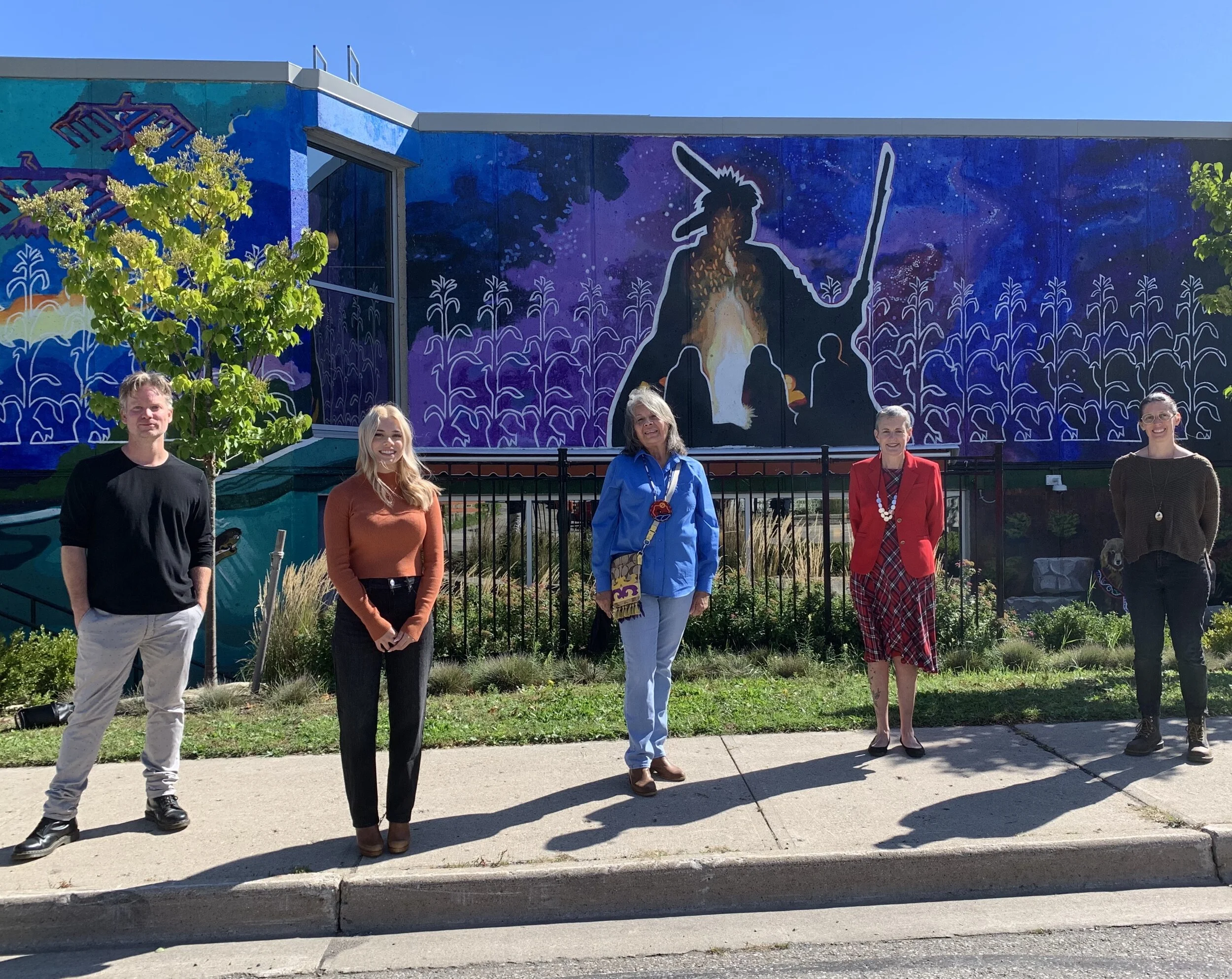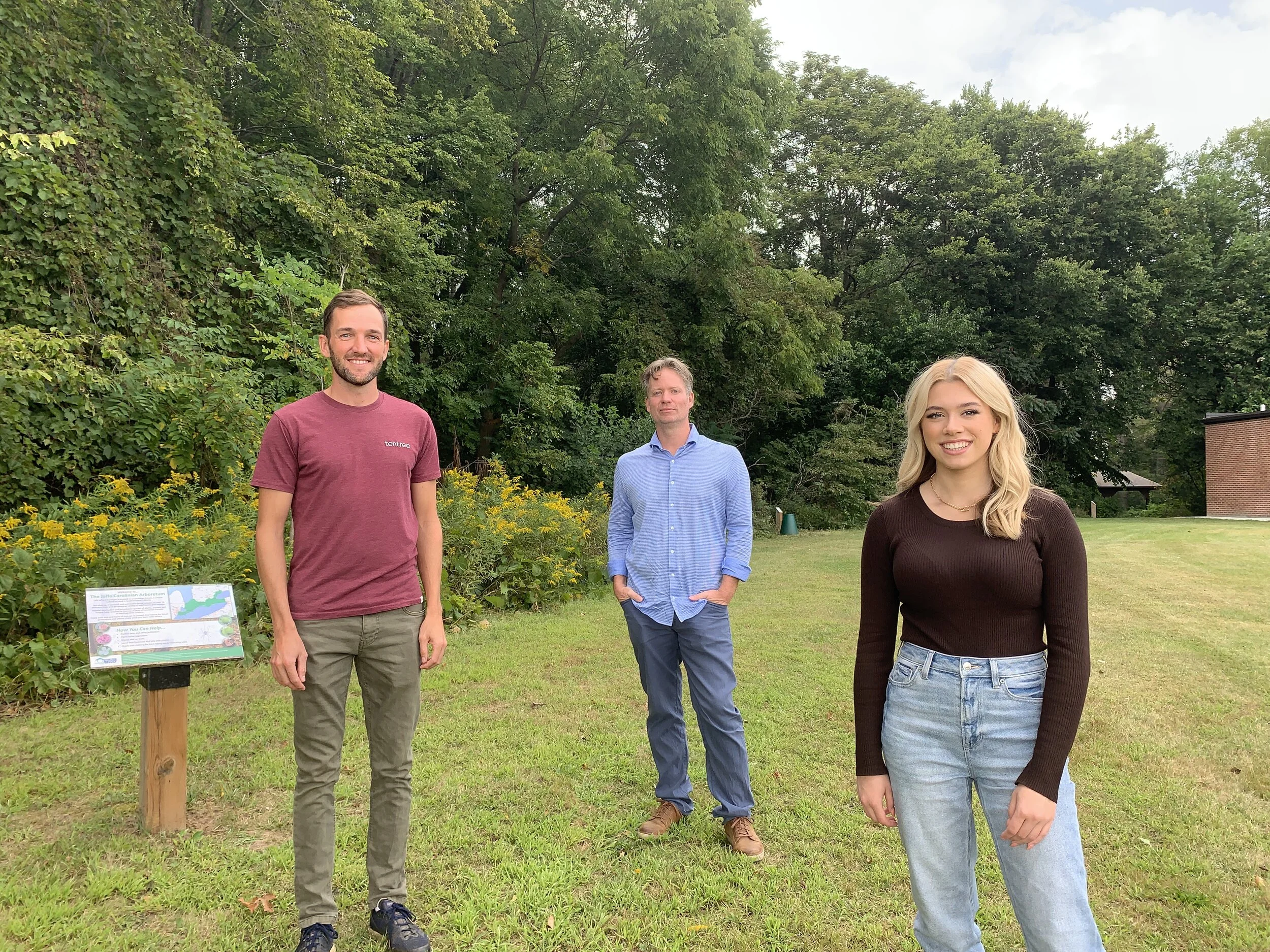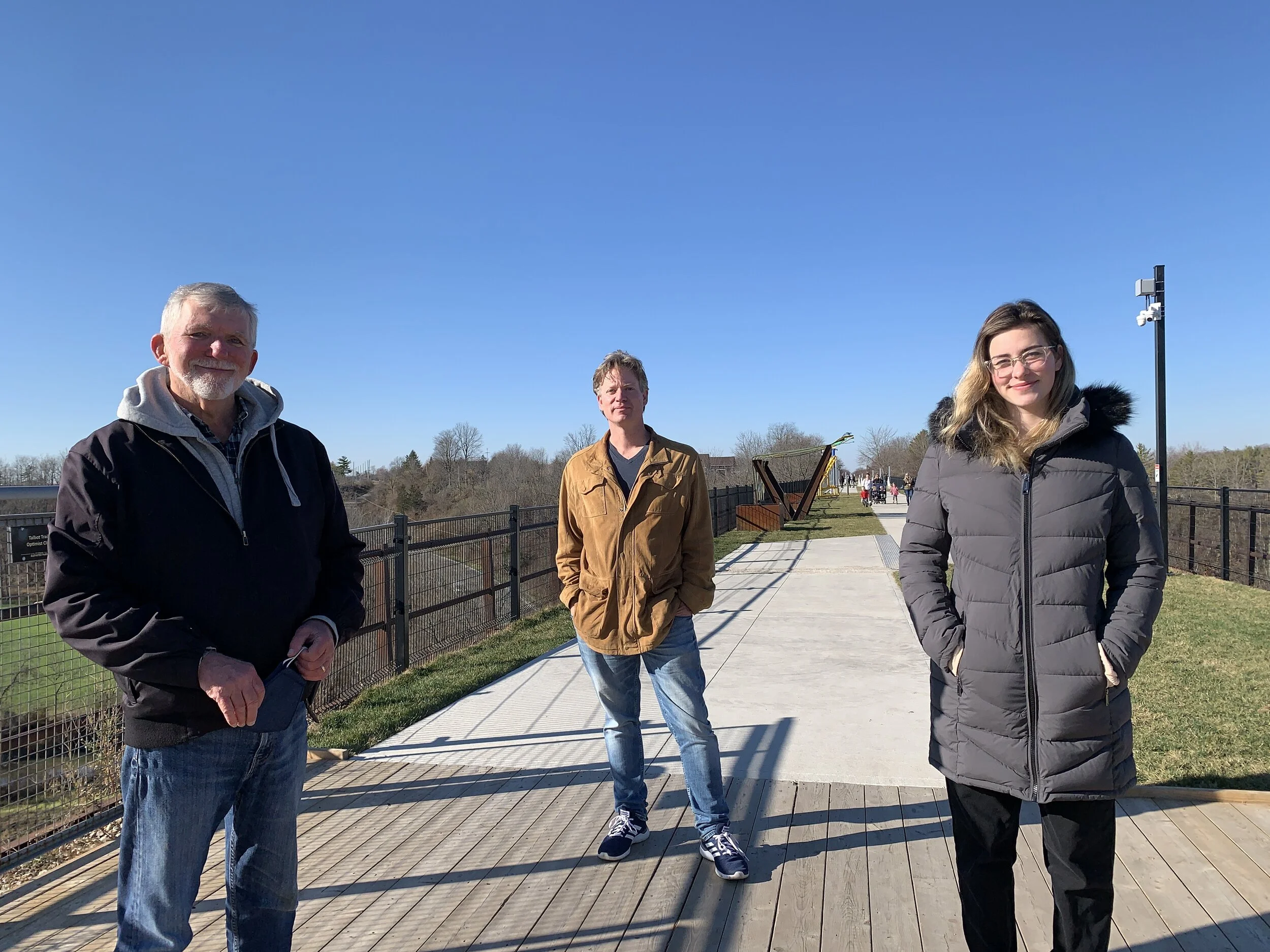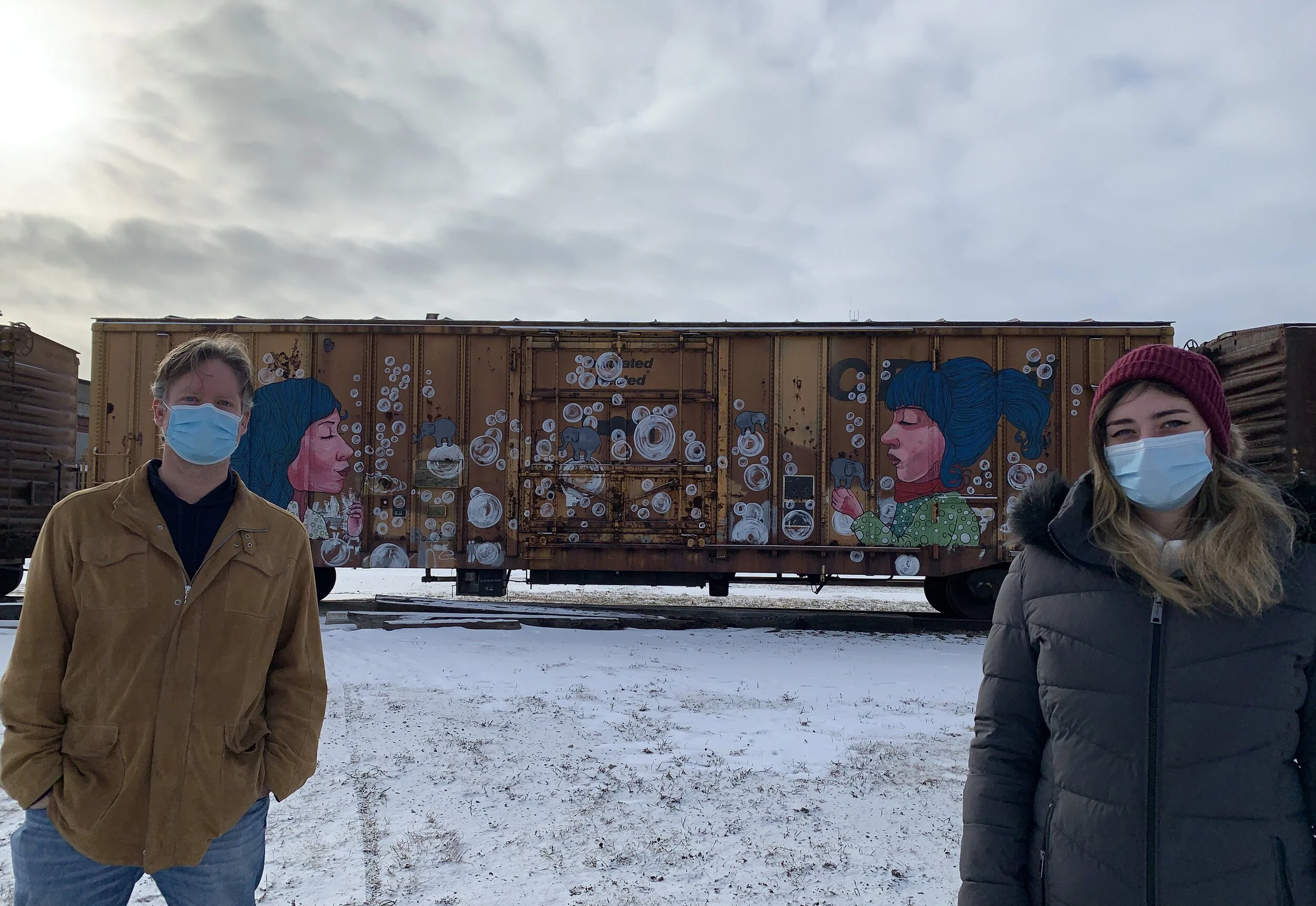New Mural by Artist Nancy Deleary Now Complete at the St. Thomas Public Library
Photo: Artist Nancy Deleary (centre) recently completed this stunning new mural titled ‘All Are My Relatives’ located above the outdoor reading garden at the St. Thomas Public Library. Deleary is joined by Andrew Gunn and Maddie King of young & free press, Heather Robinson, CEO of the St. Thomas Public Library, and Megan Pickersgill, Manager of Railway City Tourism, to celebrate the completion of the piece in September 2021.
New Mural by Artist Nancy Deleary Now Complete at the St. Thomas Public Library
The Track to the Future mural project continues in St. Thomas with the addition of a remarkable new mural by Nancy Deleary, who is an accomplished artist and also a Cultural Coordinator at Chippewas of the Thames First Nation. Completed this month above the outdoor reading garden at the St. Thomas Public Library, the artwork highlights the importance of storytelling, and will captivate the next generation of children who gather to read books and listen to speakers in the outdoor reading garden. Our team at young & free press is thrilled to coordinate the ‘Track to the Future’ mural project in collaboration with Railway City Tourism. Generous support has been provided for the artwork by the Estate of Donna Vera Evans Bushell.
Interestingly, the mural connects with the specific setting at the Library, as well as the surrounding neighbourhood. The upper portion of the artwork, visible from the street, features a fire, row of corn, and an extraordinary night sky, a spectacular setting for the central characters including a storyteller and those gathered to listen by the fire. In the lower corners of the piece, there are animals that will draw visitors into the setting. The muskrat is key to the Indigenous Re-creation story, as following the great flood, the semiaquatic rodent brought life back to earth from the depths through a morsel of sand. Viewers will note that the muskrat has a bandolier bag, which has always been a part of First Nations and Native American attire. There is also a mother bear and cub in the design. Similar to the muskrat, the mother bear is wearing a bandolier bag, symbolizing that all of creation has been given a set of original instructions and responsibilities that they have always maintained. The animals are situated in the space to remind human beings that we share the natural environment. This is emphasized by how the bear and cub are positioned on rock formations that visually extend the reading garden amphitheatre. All living things are in the same spot. The bear is traditionally considered a protector and maintains a very close relationship to the earth.
The corn in the design connects to the adjacent roadway, Mondamin Street, as Mondamin is the Ojibwa word for corn. Prompted by this fact, Deleary noted that there are other local street names that reference First Nations culture, such as Hiawatha, Meda, Omemee, and Owaissa. The names were inspired by the work of Henry Wadsworth Longfellow, the American poet popular in the 19th century who has since earned a mixed reputation. His epic poem ‘The Song of Hiawatha’ features Indigenous characters, and apparently influenced the naming of streets in the Great Lakes region; however, he took considerable license in his work and many would view the poem now as an example of cultural appropriation. With the mural design, Deleary has referenced this historical note while simultaneously rooting the word again in the context of First Nations culture.
Artist Statement by Nancy Deleary
“I grew up not knowing anything about who I am as a member of the Chippewas of the Thames First Nation. I could not speak my original language; I did not know what Chippewas did, and I had heard no stories about where we came from and what we had done.
This situation we were and still are in for many of us, was designed to be this way.
A thousand years ago my ancestors prophesized that there was going to be a force that would come to this land and disrupt their way of life. A great migration of the Anishinaabeg (1) began that saw many people leave their ancestral lands and travel west to settle around the Great Lakes and beyond to safeguard themselves. The language, knowledges and ceremonies were hidden and only recently have been surfaced to reteach those of us who were forced to forget.
There is currently a movement throughout the First Nations and Native American people of this continent to revitalize and reclaim who we are.
We have been told to share our knowledges, for it is our perspective that will aid in the situation our earth is in now. The detrimental effects of climate change are set in motion and decisions need to be made to secure life for the future.
We are now remembering, and we are now speaking.”
(1) “Anishinaabe.” “People from whence lowered” Benton-Banai, Edward. The Mishomis Book. Saint Paul, Indian Country Press, Inc. 1979.
Photo by Andrew Gunn, young & free press.
Statement by Megan Pickersgill, Manager, Railway City Tourism
“The addition of Nancy’s mural to our public art sphere is significant, as it gives a beautiful voice to the Indigenous cultures of the region. The tapestry of murals around St. Thomas tell many different stories, and having Nancy’s voice as a part of that adds a new and important dimension. The symbolism and connection to our community through art is evident, and we encourage everyone to visit and sit awhile with this masterpiece.”
Statement by Heather Robinson, CEO, St. Thomas Public Library
“This mural beckons one to stay and sit with it for a while to take in all of its detail and meaning. We’ve already had children requesting that they be allowed to sit on the rocks with the bear, in fact. We are honoured to be the host for such an incredible and meaningful piece of artwork.”
Statement by Andrew Gunn, Consultant, The Estate of Donna Vera Evans Bushell, and Owner and Editor of young & free press
“We are very grateful to Nancy Deleary for imagining and painting this gorgeous and profound mural for the community. Through the Track to the Future mural project, we have been able to provide opportunities for many artists to share stories and add depth and beauty to St. Thomas. Ultimately, our goal is for the city to feel welcoming and inviting, and for the artwork to generate conversations, promote health and well-being, and inspire residents and visitors alike.”
Notes on The Estate of Donna Bushell
Donna Vera Evans Bushell passed away November 9, 2019, in her hundredth year, the last of her family. Donna’s passion was to plant trees and reminisce about her ancestors and friends while her sister Doris Evans taught music as a church organist. The oldest sister, Thelma Joiner, taught elementary school around Aylmer for forty-five years and researched local North Yarmouth history. All three sisters shared a love of their heritage as descendants of the pioneer Westlake, Penhale and Gilbert families who settled along the North Edgeware Road in Yarmouth. Their collected historical papers will eventually be deposited in the Elgin County Archives. More than $2.5M has been allocated from the Estate to date in support of a series of exciting projects in Elgin County and St. Thomas, including the Track to the Future mural project, the establishment of the Evans Sisters’ Water Trail at Dalewood Conservation Area, and the forthcoming construction of the Evans Sisters’ Stage at Springwater Forest.
Notes on the St. Thomas EDC and Railway City Tourism
Established in 1957, the St. Thomas Economic Development Corporation is governed by a volunteer Board of Directors and is one of the oldest such organizations in Canada, serving the City of St. Thomas with the mission of improving the quality of life for all citizens of the community. In 2013, the EDC and the City recognized that Tourism plays a large role in achieving that mission, which led to the creation of Railway City Tourism.







